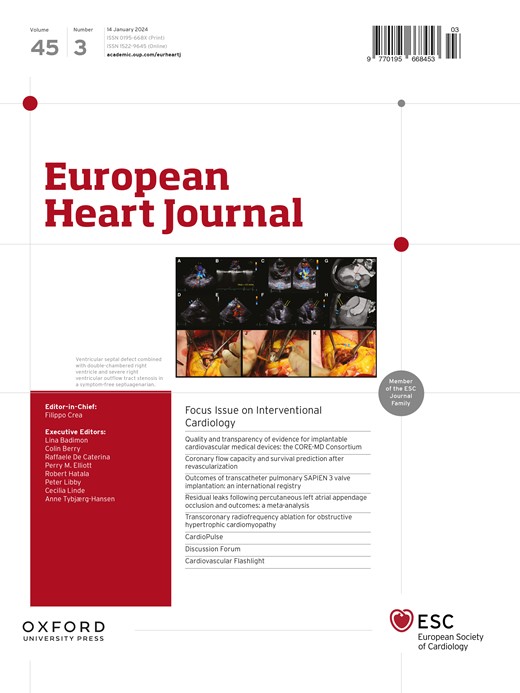牛磺酸脱氧胆酸可减轻肥胖引起的内皮功能障碍
IF 35.6
1区 医学
Q1 CARDIAC & CARDIOVASCULAR SYSTEMS
引用次数: 0
摘要
背景和目的肥胖是一个全球性的健康挑战,显著增加了心血管疾病(CVD)负担。有效的预防和治疗需要针对早期病理改变,特别是肥胖引起的内皮功能障碍(ED)。本研究旨在表征非高血压性肥胖(NHO)个体ED的异质性,探讨血清代谢物与肥胖诱导ED的关系,并确定潜在的预测和治疗代谢物。方法采用钢丝肌图对213例NHO患者大网膜脂肪组织的离体小动脉ED进行测定,并将其分为代谢健康型肥胖(MHO)和代谢不健康型肥胖(MUO)。目标代谢组学分析确定了血清代谢物与ED之间的关联。结果NHO患者肥胖引起的ED与许多传统心血管危险因素缺乏相关性。MHO和MUO个体表现出相似的ED和代谢组学特征。血清代谢组学鉴定胆汁酸(BAs),特别是鹅去氧胆酸(CDCA)与NHO患者ED呈负相关。牛磺酸脱氧胆酸(TCDCA)是一种牛磺酸缀合衍生物,可预防肥胖引起的ED和高血压。从机制上讲,内皮法内脂X受体(FXR)缺失加重了肥胖诱导的ED和高血压,抵消了减肥手术或TCDCA治疗的有益效果。内皮细胞中TCDCA-FXR的激活上调ATF4的转录,而ATF4的转录被PHB1抑制,从而增强丝氨酸和单碳代谢。结论:CDCA是鉴别肥胖性ED的一种有前景的生物标志物,牛磺酸在缓解多种肥胖性ED方面具有显著的治疗潜力。这种作用是由内皮细胞TCDCA-FXR-PHB1-ATF4轴介导的,该轴上调丝氨酸和单碳代谢,从而为延缓高血压和其他心血管疾病的发生提供了一种新的策略。本文章由计算机程序翻译,如有差异,请以英文原文为准。
Taurochenodeoxycholic acid alleviates obesity-induced endothelial dysfunction
Background and Aims Obesity is a global health challenge significantly increasing cardiovascular disease (CVD) burden. Effective prevention and treatment necessitate targeting early pathological changes, particularly obesity-induced endothelial dysfunction (ED). This study aimed to characterize ED heterogeneity in non-hypertensive obese (NHO) individuals, investigate the association of serum metabolites with obesity-induced ED, and identify potentially predictive and therapeutic metabolites. Methods Utilizing wire myograph, this study assessed ED of ex vivo arterioles from omental adipose tissue of 213 NHO patients, categorized into metabolically healthy obesity (MHO) and metabolically unhealthy obesity (MUO). Targeted metabolomic profiling identified associations between serum metabolites and ED. Results Obesity-induced ED in NHO patients lacked correlations with many traditional cardiovascular risk factors. The MHO and MUO individuals exhibited similar ED and metabolomic profile characteristics. Serum metabolomics identified bile acids (BAs), particularly chenodeoxycholic acid (CDCA), as negatively correlated with ED in NHO patients. Taurochenodeoxycholic acid (TCDCA), a taurine-conjugated derivative of CDCA, protected against obesity-induced ED and hypertension. Mechanistically, endothelial Farnesoid X receptor (FXR) deletion aggravated obesity-induced ED and hypertension, negating the beneficial effects of bariatric surgery or TCDCA treatment. The TCDCA-FXR activation in endothelial cells upregulated ATF4 transcription, which was suppressed by PHB1, thereby enhancing serine and one-carbon metabolism. Conclusions This study suggests CDCA as a promising biomarker for identification of obesity-induced ED. Taurochenodeoxycholic acid demonstrates significant therapeutic potential for alleviating various forms of obesity-induced ED. This effect is mediated by the endothelial TCDCA-FXR-PHB1-ATF4 axis, which upregulates serine and one-carbon metabolism, thereby offering a novel strategy to delay the onset of hypertension and other CVDs.
求助全文
通过发布文献求助,成功后即可免费获取论文全文。
去求助
来源期刊

European Heart Journal
医学-心血管系统
CiteScore
39.30
自引率
6.90%
发文量
3942
审稿时长
1 months
期刊介绍:
The European Heart Journal is a renowned international journal that focuses on cardiovascular medicine. It is published weekly and is the official journal of the European Society of Cardiology. This peer-reviewed journal is committed to publishing high-quality clinical and scientific material pertaining to all aspects of cardiovascular medicine. It covers a diverse range of topics including research findings, technical evaluations, and reviews. Moreover, the journal serves as a platform for the exchange of information and discussions on various aspects of cardiovascular medicine, including educational matters.
In addition to original papers on cardiovascular medicine and surgery, the European Heart Journal also presents reviews, clinical perspectives, ESC Guidelines, and editorial articles that highlight recent advancements in cardiology. Additionally, the journal actively encourages readers to share their thoughts and opinions through correspondence.
 求助内容:
求助内容: 应助结果提醒方式:
应助结果提醒方式:


